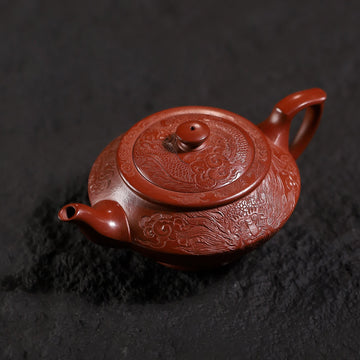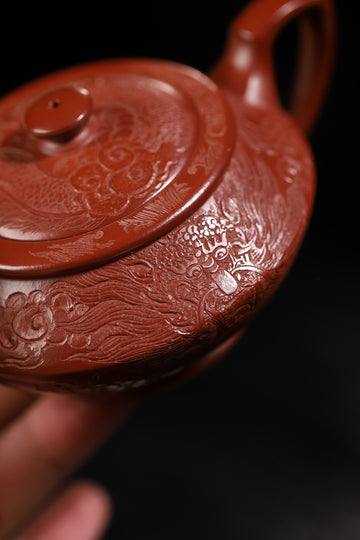The emergence of slipcast "purple clay teapots" is primarily rooted in the historical pursuit of high-efficiency production and the need to meet market demands for lower-cost products. However, these items fundamentally deviate from the traditional essence and craftsmanship of authentic Yixing Zisha teapots.
Why Slip-Cast Teapots Emerged
The history of slip-cast teapots can be traced back to the 1950s and 1960s. Around 1958, in response to the national policy of increasing production efficiency, the Yixing Purple Clay Factory began exploring methods for mass-producing teapots. They attempted to introduce the slip-casting technique from the ceramic industry into purple clay teapot production. The initial experiments involved grinding authentic purple clay raw materials into a slurry, which was then poured into pre-made plaster molds. The plaster's strong absorbency allowed the blank to form quickly and be demolded in a short time. Howeve
r, this process caused the clay to lose the characteristic sandy texture and particle feel of purple clay, and the resulting teapots exhibited significantly reduced performance in all aspects. Consequently, this early attempt was considered a failure.
With the revival of the purple clay teapot market in later periods, slip-cast teapots made a comeback. To reduce costs and simplify the production process, manufacturers often ceased using authentic Yixing Zisha clay altogether. Instead, they began using other types of pottery clay mixed with water glass (sodium silicate solution, commonly used in construction as an adhesive or sealant) to create the slurry. From this point on, whether judged by the raw materials or the manufacturing process, slip-cast products could no longer be classified as genuine purple clay teapots.
How Slip-Cast Teapots Are Produced


The production process for slip-cast teapots is entirely different from that of traditional handmade purple clay teapots and primarily involves three stages:
-
Clay Preparation: The raw materials—often low-quality pottery clay or external mountain clay rather than authentic Yixing Zisha clay—are ground extremely finely in a ball mill for up to 48 hours. The fineness of the clay powder typically reaches about 200 mesh (authentic handmade purple clay teapots usually use clay in the 40-60 mesh range). Substances like water glass and wax are added to the slurry to increase fluidity and facilitate demolding.
-
Slip-Casting and Forming: The prepared slurry is heated and poured into plaster molds. The molds' high absorbency causes the slurry to form a uniform blank on the inner wall of the mold. After approximately 15-30 minutes, the drain hole at the bottom of the mold is opened to release the excess slurry, followed by demolding. This method is highly efficient, allowing a single worker to produce 300 to 500 teapot blanks per day.
-
Post-Processing and Firing: After demolding, components like the spout and handle need to be installed, and simple finishing work is performed. The teapots are then fired in a kiln, typically at a temperature 100-200°C lower than that used for authentic purple clay teapots.
How to Identify Slip-Cast Teapots

Distinguishing slip-cast teapots from genuine handmade purple clay teapots is not difficult. By focusing on the following key aspects, you can avoid being deceived:
1. Observe the Surface Texture and Feel
-
Authentic Purple Clay Teapot: The surface has a distinct sandy, granular texture and feels slightly rough to the touch. The luster is warm and subtle, deepening with use.
-
Slip-Cast Teapot: Because the clay is ground into an extremely fine slurry and contains additives like water glass, the surface appears excessively smooth and glossy, often with a harsh, "flashy" shine. The color may look unnaturally bright.
2. Check for Imperfections and Craftsmanship Marks
-
Authentic Purple Clay Teapot: Signs of handcrafting are visible inside the pot, such as "push marks" and "bottom scraping" traces from tooling. The connection points for the spout and handle are neatly finished.
-
Slip-Cast Teapot: The interior is often unnaturally smooth, lacking any handcrafting marks. A noticeable mold line might be visible from the spout extending to the body, a result of the mold casting process. The wall thickness is often uniformly thin.
3. Perform the Water Test (Breathability)
-
Authentic Purple Clay Teapot: Thanks to its unique double-porosity structure, it has excellent breathability. When hot water is poured over the pot, the water is quickly absorbed and spreads evenly, drying relatively fast.
-
Slip-Cast Teapot: The fine clay and additives clog the pores, resulting in poor breathability. Water droplets poured on the surface tend to stay round and roll off, evaporating very slowly.
4. Assess the Weight and Sound
-
Authentic Purple Clay Teapot: Feels substantial and solid in the hand. Tapping the body gently with the lid produces a crisp but relatively dull, deep sound—more like a "clunk" than a ring.
-
Slip-Cast Teapot: Often feels noticeably lighter due to the thin walls. Tapping it produces a sharper, higher-pitched, ringing sound similar to porcelain or glass.
5. Consider the Price Realistically
Given their low production costs, slip-cast teapots are typically very cheap, often priced between a few dozen to a hundred yuan. Encountering a "purple clay teapot" at an extremely low price, especially one that comes with many extra cups and saucers, is a major red flag. A genuine semi-handmade purple clay teapot from a reputable artisan typically cannot be purchased for less than a few hundred yuan.
The following table summarizes the key differences for quick comparison:
|
Identification Feature |
Authentic Purple Clay Teapot |
Slip-Cast Teapot |
|---|---|---|
|
Surface Texture |
Natural sandy, granular feel; warm, subtle luster |
Overly smooth; often has a harsh, plastic-like shine |
|
Craftsmanship Marks |
Visible handcrafting marks inside (e.g., tool lines) |
Interior is perfectly smooth; may have mold lines |
|
Water Test |
Excellent water absorption; water spreads and dries quickly |
Poor absorption; water beads and rolls off slowly |
|
Weight & Sound |
Substantial feel; tapping produces a deep, dull sound |
Lightweight; tapping produces a sharp, ringing sound |
|
Typical Price Range |
Several hundred yuan and above (semi-handmade) |
Often between 10-100 RMB(<20$) |
Conclusion
Slip-cast teapots emerged from a specific historical context aimed at mass production but ultimately failed to preserve the essential qualities of purple clay. They are characterized by the use of non-Zisha clay and a molding process that results in a product lacking the breathability, aesthetic value, and tea-enhancing qualities of authentic Yixing teapots. By carefully observing the texture, workmanship, breathability, and price, collectors can effectively identify them. For true tea enthusiasts, choosing a teapot made through traditional craftsmanship is not only a pursuit of quality but also a respect for the profound cultural heritage of Yixing Zisha.






